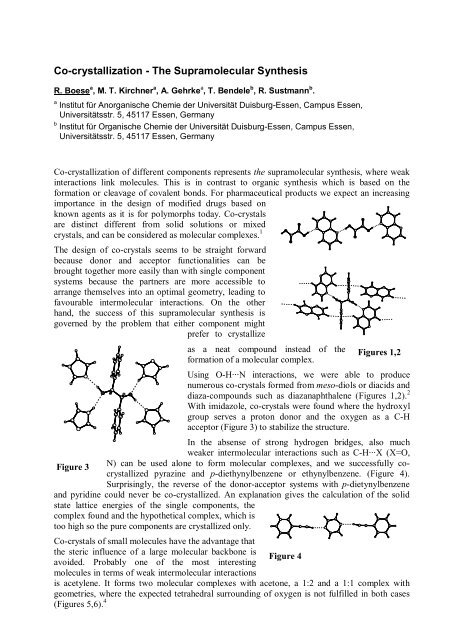Co-crystallization - The Supramolecular Synthesis
Co-crystallization - The Supramolecular Synthesis
Co-crystallization - The Supramolecular Synthesis
Create successful ePaper yourself
Turn your PDF publications into a flip-book with our unique Google optimized e-Paper software.
<strong>Co</strong>-<strong>crystallization</strong> - <strong>The</strong> <strong>Supramolecular</strong> <strong>Synthesis</strong><br />
R. Boese a , M. T. Kirchner a , A. Gehrke a , T. Bendele b , R. Sustmann b .<br />
a Institut für Anorganische Chemie der Universität Duisburg-Essen, Campus Essen,<br />
Universitätsstr. 5, 45117 Essen, Germany<br />
b Institut für Organische Chemie der Universität Duisburg-Essen, Campus Essen,<br />
Universitätsstr. 5, 45117 Essen, Germany<br />
<strong>Co</strong>-<strong>crystallization</strong> of different components represents the supramolecular synthesis, where weak<br />
interactions link molecules. This is in contrast to organic synthesis which is based on the<br />
formation or cleavage of covalent bonds. For pharmaceutical products we expect an increasing<br />
importance in the design of modified drugs based on<br />
known agents as it is for polymorphs today. <strong>Co</strong>-crystals<br />
are distinct different from solid solutions or mixed<br />
crystals, and can be considered as molecular complexes. 1<br />
<strong>The</strong> design of co-crystals seems to be straight forward<br />
because donor and acceptor functionalities can be<br />
brought together more easily than with single component<br />
systems because the partners are more accessible to<br />
arrange themselves into an optimal geometry, leading to<br />
favourable intermolecular interactions. On the other<br />
hand, the success of this supramolecular synthesis is<br />
governed by the problem that either component might<br />
prefer to crystallize<br />
as a neat compound instead of the Figures 1,2<br />
formation of a molecular complex.<br />
Using O-H···N interactions, we were able to produce<br />
numerous co-crystals formed from meso-diols or diacids and<br />
diaza-compounds such as diazanaphthalene (Figures 1,2). 2<br />
With imidazole, co-crystals were found where the hydroxyl<br />
group serves a proton donor and the oxygen as a C-H<br />
acceptor (Figure 3) to stabilize the structure.<br />
In the absense of strong hydrogen bridges, also much<br />
weaker intermolecular interactions such as C-H···X (X=O,<br />
Figure 3<br />
N) can be used alone to form molecular complexes, and we successfully cocrystallized<br />
pyrazine and p-diethynylbenzene or ethynylbenzene. (Figure 4).<br />
Surprisingly, the reverse of the donor-acceptor systems with p-dietynylbenzene<br />
and pyridine could never be co-crystallized. An explanation gives the calculation of the solid<br />
state lattice energies of the single components, the<br />
complex found and the hypothetical complex, which is<br />
too high so the pure components are crystallized only.<br />
<strong>Co</strong>-crystals of small molecules have the advantage that<br />
the steric influence of a large molecular backbone is<br />
Figure 4<br />
avoided. Probably one of the most interesting<br />
molecules in terms of weak intermolecular interactions<br />
is acetylene. It forms two molecular complexes with acetone, a 1:2 and a 1:1 complex with<br />
geometries, where the expected tetrahedral surrounding of oxygen is not fulfilled in both cases<br />
(Figures 5,6). 4
Figures 5,6<br />
Even for C-H...pi interactions, the geometries<br />
remain unpredictable. We were able to cocrystallize<br />
acetylene with benzene (Figure 7), 5 m-<br />
xylene or mesitylene, but we were unable to get a<br />
molecular complex from acetylene and toluene. In<br />
the prior case, the acetylene molecule fulfils a<br />
precession-like movement even at temperatures of<br />
120K.<br />
<strong>The</strong> unexpected geometries underline the<br />
electrostatic character of the hydrogen bond, and<br />
make it even more difficult to predict the packing<br />
of molecular complexes because of the low<br />
directionality of the bond. <strong>The</strong>refore much<br />
experience and intuition is needed to have reasonable<br />
approaches to supramolecular synthesis.<br />
Figure 7<br />
References<br />
1. Gautam R. Desiraju, CrystEng<strong>Co</strong>mm, 2003, 5, 466-467; Jack D. Dunitz, CrystEng<strong>Co</strong>mm,<br />
2003, 5, 506.<br />
2. Tanja Smolka, Reiner Sustmann, Roland Boese, J. Prakt. Chem. 1999, 341, 378-383;<br />
Tanja Smolka, Thorsten Schaller, Reiner Sustmann, Dieter Bläser, Roland Boese, J. Prakt.<br />
Chem. 2000, 5, 465-472.<br />
3. Tanja Bendele, Reiner Sustmann, Roland Boese, unpublished<br />
4. Roland Boese, Michael T. Kirchner, Ed W. Billups, Lewis R. Norman, Angew. Chem. Int.<br />
Ed., 2003, 42, 1961-1963.<br />
5. Roland Boese, Timothy Clark, Angelo Gavezzotti, Hel. Chim. Acta, 86, 2003, 1085-1100.






